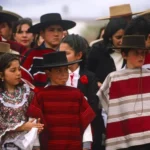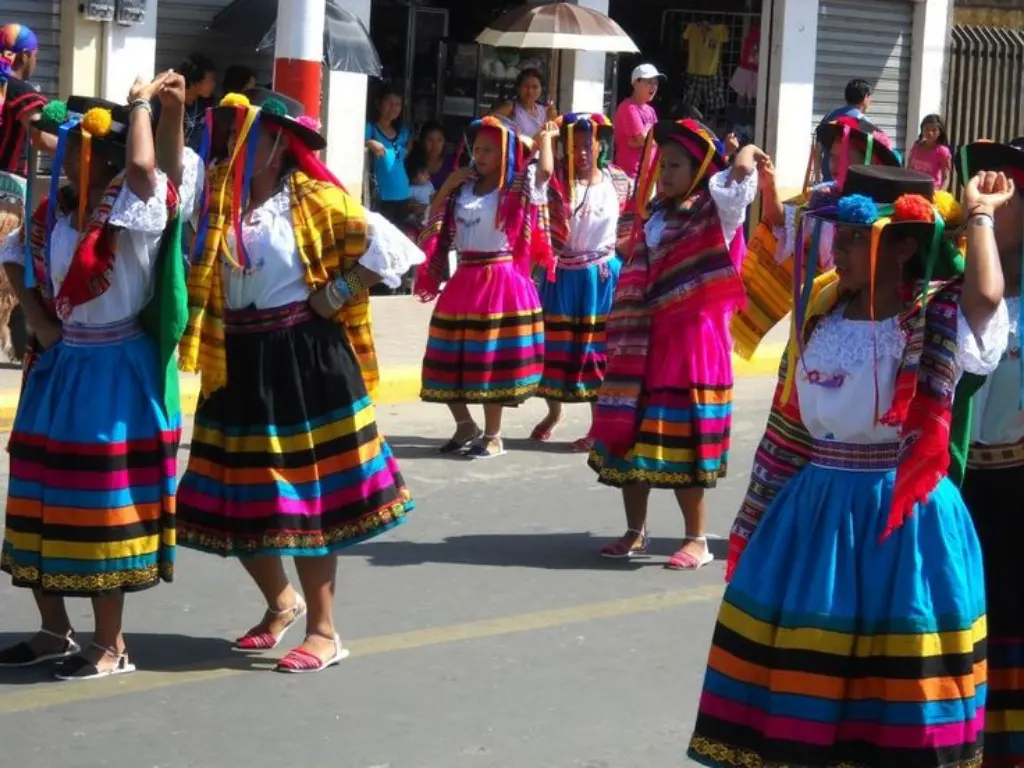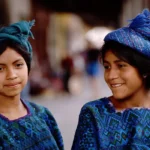Ecuador’s traditional clothing is a vivid expression of its diverse cultural heritage, shaped by indigenous traditions, Spanish colonial influence, and regional variations.
The attire showcases intricate designs, natural materials, and vibrant colors, reflecting the country’s connection to its past and its natural environment. From the Andes to the coast and the Amazon, each region boasts unique styles that tell stories of identity and community.
The Historical Roots of Ecuadorian Attire
Pre-Columbian Influences
Indigenous communities in Ecuador have worn traditional garments for centuries, often made from locally sourced materials like alpaca wool and cotton. These garments served both practical and ceremonial purposes:
- 🧙♀️ Ponchos: Used by Andean men for warmth and as a symbol of status within their communities. The ponchos were often dyed with natural pigments and featured patterns that conveyed familial or tribal affiliations.
- 🪑 Woven Belts (Fajas): Featured geometric patterns that carried spiritual and cultural meanings. The weaving techniques and motifs varied between regions, showcasing the artistry of each community.
- 🧩 Headpieces: Elaborate headbands or hats adorned with feathers and beads were common in ceremonies, often symbolizing a connection to nature and the spiritual world.

Colonial Era Adaptations
Spanish colonization introduced new fabrics like silk and lace, as well as European styles. Indigenous attire began to blend these elements with traditional designs, creating the unique hybrid costumes seen today. Wealthier indigenous groups adopted finer materials, while others retained their use of natural fibers, maintaining the practicality of their garments.
See also Traditional Clothing in Chile: A Blend of Tradition and Identity
Traditional Clothing in Chile: A Blend of Tradition and Identity
During this period, traditional clothing also became a marker of identity and resistance. Many indigenous communities integrated Spanish elements into their attire while preserving their distinctive weaving techniques and motifs.
Cultural Preservation
Over time, traditional clothing became a symbol of resistance and identity, helping indigenous communities preserve their heritage despite external influences. Today, these garments are not only worn with pride during festivals and rituals but also serve as a visual testament to Ecuador’s multicultural history.
Key Elements of Ecuadorian Traditional Clothing
Men’s Attire

- 🧙♂️ Ponchos: Typically red or deep blue, these woolen garments are worn over white shirts and paired with loose trousers. The vibrant colors and patterns of ponchos often represent the wearer’s region and social status.
- 🧟 Panama Hats: Contrary to their name, Panama hats originate from Ecuador and are meticulously handwoven from toquilla straw. They are an iconic accessory, combining functionality with timeless elegance.
- 🧩 Sashes: Brightly colored woven belts that secure the trousers and add a pop of color to the outfit. These sashes often incorporate intricate patterns that hold symbolic meanings.
- 🧤 Sandals (Alpargatas): Handmade footwear crafted from natural fibers like hemp or cotton, designed for comfort and durability.
Women’s Attire
- 🧙 Anacos (Skirts): Layered wool or cotton skirts, often adorned with intricate embroidery or bold stripes. The anaco is traditionally secured with a wide, decorative belt, adding elegance to the outfit.
- 🧩 Blouses: White blouses featuring lace detailing, pleats, and vibrant floral embroidery. These blouses are typically tailored to fit snugly, emphasizing the craftsmanship involved.
- 🧲 Shawls (Rebozos): Colorful woven shawls that are both decorative and functional, used for warmth and as a way to carry goods or children. The rebozos are often passed down through generations, symbolizing familial ties.
- 💍 Jewelry: Women frequently wear layered necklaces made of gold or glass beads, often accompanied by large earrings. These accessories not only enhance the outfit but also signify social status and cultural heritage.

Accessories
- 🌿 Hats: Felt or wool hats, varying by region, are a staple for both men and women. In the highlands, women often wear bowler hats, while men favor wide-brimmed styles.
- 🧙 Scarves and Belts: These often display traditional patterns and vibrant hues, serving as both functional and decorative elements.
Regional Variations in Ecuadorian Attire
Andean Highlands

The clothing of the Andes reflects the region’s cooler climate and strong indigenous heritage. Garments are often made from thick wool, providing warmth while showcasing intricate designs.
- 🗻 Otavalo: Renowned for their weaving, Otavalo men wear white trousers, blue ponchos, and long braided hair, while women don white embroidered blouses, black skirts, and gold necklaces. The Otavalo market is famous for its high-quality textiles, which often feature traditional patterns.
- 🌄 Chimborazo: Known for heavy woolen ponchos and layered skirts, often accessorized with felt hats adorned with feathers. Women in this region frequently wear brightly colored shawls and ornate jewelry.
Coastal Region

The attire here is lighter, reflecting the warmer climate and Afro-Ecuadorian influences. Coastal clothing combines practicality with vibrant aesthetics, showcasing the region’s dynamic culture.
See also Traditional Clothing in Guatemala: A Vibrant Cultural Legacy
Traditional Clothing in Guatemala: A Vibrant Cultural Legacy
- 💧 Montubio: Men wear straw hats, white shirts, and cotton trousers, while women favor loose-fitting dresses with floral patterns. These outfits are particularly prominent during traditional dances and festivities.
- 🏖️ Festive Costumes: Coastal festivals showcase bright, flowing garments and intricate beadwork, reflecting the region’s celebratory spirit.
Amazon Rainforest
In the Amazon, traditional clothing is adapted to the tropical environment. The simplicity and functionality of the attire reflect the natural surroundings.

- 🌳 Kichwa: Garments are often minimal, made from natural fibers and dyed with plant-based pigments. These outfits are complemented by body paint, which holds cultural and spiritual significance.
- 🧐 Body Paint: Used as a decorative and symbolic element, often paired with bead necklaces and feathered headpieces. This practice highlights the close connection between the Amazonian communities and their environment.
Urban and Modern Adaptations
In cities like Quito and Guayaquil, traditional clothing is often reserved for special occasions. However, elements like Panama hats and embroidered blouses are increasingly incorporated into everyday fashion, bridging the gap between tradition and modernity.
Cultural Significance of Traditional Clothing
Traditional Ecuadorian clothing is not merely functional but deeply symbolic. Each piece reflects the wearer’s identity, social status, and community ties. The vibrant colors and patterns often carry spiritual or historical meanings, connecting the present to the past.

Festivals and Celebrations
During events like Inti Raymi or Mama Negra, traditional attire plays a central role. Participants don elaborate costumes adorned with beads, feathers, and embroidery to honor their heritage. These celebrations serve as a vibrant display of Ecuador’s cultural diversity and artistic craftsmanship.
Preservation Efforts
- 🌍 Weaving Cooperatives: Communities like Otavalo and Saraguro have established weaving cooperatives to sustain traditional techniques. These organizations provide a platform for artisans to showcase and sell their work.
- 📚 Cultural Education: Schools and museums promote awareness of traditional clothing through workshops and exhibitions, ensuring younger generations understand its significance.
- 🎨 Modern Fashion: Designers are reinterpreting traditional garments for contemporary audiences, blending historical elements with modern aesthetics to create unique pieces.
A Living Legacy
Traditional clothing in Ecuador is a vibrant testament to the nation’s cultural richness and diversity. From the Andean highlands to the Amazon rainforest, each piece tells a story of resilience, artistry, and identity. By celebrating and preserving these traditions, Ecuadorians ensure that their cultural tapestry continues to inspire and endure for generations to come.
Ecuador’s traditional attire, with its intricate designs and symbolic meanings, serves as a bridge between the past and the future. Whether worn during daily life or special celebrations, these garments remain a powerful expression of the nation’s soul.